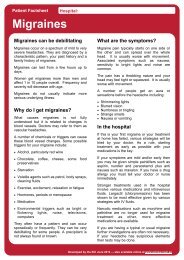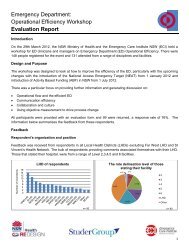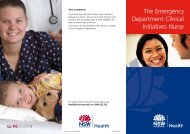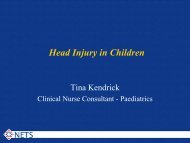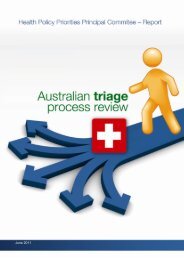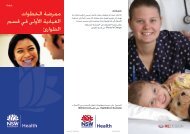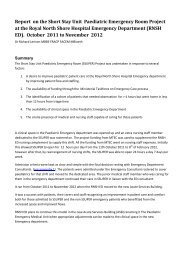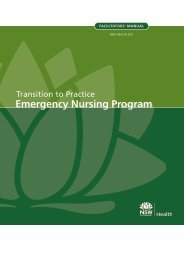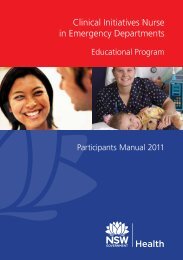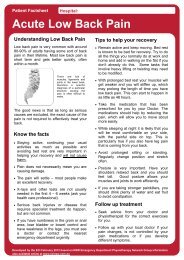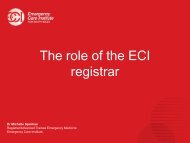Emergency Department Models of Care 2012 - NSW Health
Emergency Department Models of Care 2012 - NSW Health
Emergency Department Models of Care 2012 - NSW Health
- No tags were found...
Create successful ePaper yourself
Turn your PDF publications into a flip-book with our unique Google optimized e-Paper software.
What you need to runthe modelStaff■■■The unit is managed by the ED Director (or delegate) and Nurse ManagerClinical and operational governance <strong>of</strong> the ED SSU resides with the EDEnsure staff share an understanding <strong>of</strong> the organisational objectives for short stay andcan drive the flow <strong>of</strong> patients through the unit.Create a staffing pr<strong>of</strong>ile that includes:■■■■■A senior nurse who has first-line management responsibility for the running <strong>of</strong> the unitand will proactively ‘pull’ appropriate patients from the ED into the EDSSU to improve EDpatient flowNursing staff with well-developed clinical skills as appropriate (for example, advanced lifesupport, cannulation, venipuncture, and ECG interpretation)Medical staff who have the ability to determine clinical care requirements, and makeeffective and safe assessment and disposition decisionsAccess to Allied <strong>Health</strong> staff including Social Workers, Occupational Therapists andPhysiotherapistsPosition descriptions for all staff working in the EDSSU.Physical space■■Quarantined beds for short stay patients only. These should be in an area distinct fromthe acute ED (co-located or close to the ED) to maintain the focus on intensiveassessment, planning and intervention.Ensure that the conditions managed within the unit are appropriate to patient.Business rules■■■To function effectively, an EDSSU is dependent upon proactive management; appropriate,dedicated nursing and medical staffing; clearly defined clinical governance; and amultidisciplinary approach to patient care.Foster a culture with a focus on multidisciplinary assessment, short-term proactiveplanning and intervention, for patients who have been assessed and treated in the ED.Develop good practice policies, procedures and evidence-based guidelines. Strongmanagement and adherence to operational policies. Patients must be discharged from theEDSSU in less than 24 hours. The most effective EDSSU model will pull patients from theED.■Develop mechanisms to flag early those requiring or that have the potential to require ashort stay admission. This information should be fed to the ED SSU in a timely manner.Use clinical practice guidelines that specify:- Detailed diagnostic criteria- Admission and exclusion criteria- Baseline and subsequent investigations- Interventions including prescribing guidelines- Observations- Referrals and discharge criteria.■Define clinical review mechanisms with clear timelines.<strong>Models</strong> <strong>of</strong> <strong>Emergency</strong> <strong>Care</strong> <strong>NSW</strong> HEALTH PAGE 43




